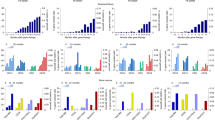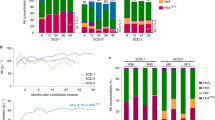Abstract
One of the major hurdles for the development of gene therapy for Fanconi anemia (FA) is the increased sensitivity of FA stem cells to free radical-induced DNA damage during ex vivo culture and manipulation. To minimize this damage, we have developed a brief transduction procedure for lentivirus vector-mediated transduction of hematopoietic progenitor cells from patients with Fanconi anemia complementation group A (FANCA). The lentiviral vector FancA-sW contains the phosphoglycerate kinase promoter, the FANCA cDNA, and a synthetic, safety-modified woodchuck post transcriptional regulatory element (sW). Bone marrow mononuclear cells or purified CD34+ cells from patients with FANCA were transduced in an overnight culture on recombinant fibronectin peptide CH-296, in low (5%) oxygen, with the reducing agent, N-acetyl-L-cysteine (NAC), and a combination of growth factors, granulocyte colony-stimulating factor (G-CSF), Flt3 ligand, stem cell factor, and thrombopoietin. Transduced cells plated in methylcellulose in hypoxia with NAC showed increased colony formation compared with 21% oxygen without NAC (P<0.03), showed increased resistance to mitomycin C compared with green fluorescent protein (GFP) vector-transduced controls (P<0.007), and increased survival. Thus, combining short transduction and reducing oxidative stress may enhance the viability and engraftment of gene-corrected cells in patients with FANCA.
This is a preview of subscription content, access via your institution
Access options
Subscribe to this journal
Receive 12 print issues and online access
$259.00 per year
only $21.58 per issue
Buy this article
- Purchase on Springer Link
- Instant access to full article PDF
Prices may be subject to local taxes which are calculated during checkout






Similar content being viewed by others
References
Bagby GC, Alter BP . Fanconi anemia (Review). Semin Hematol 2006; 43: 147–156.
Taniguchi T, D'Andrea AD . Molecular pathogenesis of Fanconi anemia: recent progress (Review). Blood 2006; 107: 4223–4233.
Wang W . Emergence of a DNA-damage response network consisting of Fanconi anaemia and BRCA proteins (Review). Nat Rev Genet 2007; 8: 735–748.
Liu JM, Kim S, Read EJ, Futaki M, Dokal I, Carter CS et al. Engraftment of hematopoietic progenitor cells transduced with the Fanconi anemia group C gene (FANCC). Hum Gene Ther 1999; 10: 2337–2346.
Yamada K, Olsen JC, Patel M, Rao KW, Walsh CE . Functional correction of fanconi anemia group C hematopoietic cells by the use of a novel lentiviral vector. Mol Ther 2001; 3: 485–490.
Yamada K, Ramezani A, Hawley RG, Ebell W, Arwert F, Arnold LW et al. Phenotype correction of Fanconi anemia group A hematopoietic stem cells using lentiviral vector. Mol Ther 2003; 8: 600–610.
Cohen-Haguenauer O, Peault B, Bauche C, Daniel MT, Casal I, Levy V et al. In vivo repopulation ability of genetically corrected bone marrow cells from Fanconi anemia patients. Proc Natl Acad Sci USA 2006; 103: 2340–2345.
Kelly PF, Radtke S, von Kalle C, Balcik B, Bohn K, Mueller R et al. Stem cell collection and gene transfer in Fanconi anemia. Mol Ther 2007; 15: 211–219.
Müller LU, Milsom MD, Kim MO, Schambach A, Schuesler T, Williams DA . Rapid lentiviral transduction preserves the engraftment potential of Fanca(−/−) hematopoietic stem cells. Mol Ther 2008; 16: 1154–1160.
Jacome A, Navarro S, Rio P, Yañez RM, González-Murillo A, Lozano ML et al. Lentiviral-mediated genetic correction of hematopoietic and mesenchymal progenitor cells from Fanconi anemia patients. Mol Ther 2009; 17: 1083–1092.
Butturini A, Gale RP, Verlander PC, Aldler-Bricner B, Gillio AP, Auerbach AD . Hematologic abnormalities in Fanconi anemia: An International Fanconi Anemia Registry Study. Blood 1994; 84: 1650–1655.
Laufs S, Guenechea G, Gonzalez-Murillo A, Zsuzsanna Nagy K, Luz Lozano M, del Val C et al. Lentiviralvector integration sites in human NOD/SCID repopulating cells. J Gene Med 2006; 8: 1197–1207.
Beard BC, Keyser KA, Trobridge GD, Peterson LJ, Miller DG, Jacobs M et al. Unique integration profiles in a canine model of long-term repopulating cells transduced with gammaretrovirus, lentivirus, and foamy virus. Hum Gene Ther 2007; 18: 423–434.
Alter BP, Knobloch ME, Weinberg RS . Erythropoiesis in Fanconi's anemia. Blood 1991; 78: 602–608.
Waisfisz Q, Morgan NV, Savino M, de Winter JP, van Berkel CG, Hoatlin ME et al. Spontaneous functional correction of homozygous fanconi anaemia alleles reveals novel mechanistic basis for reverse mosaicism. Nat Genet 1999; 22: 379–383.
Gregory Jr JJ, Wagner JE, Verlander PC, Levran O, Batish SD, Eide CR et al. Somatic mosaicism in Fanconi anemia: evidence of genotypic reversion in lymphohematopoietic stem cells. Proc Natl Acad Sci USA 2001; 98: 2532–2537.
Zufferey R, Donello JE, Trono D, Hope TJ . Woodchuck hepatitis virus posttranscriptional regulatory element enhances expression of transgenes delivered by retroviral vectors. J Virol 1999; 73: 2886–2892.
Kingsman SM, Mitrophanous K, Olsen JC . Potential oncogene activity of the woodchuck hepatitis post-transcriptional regulatory element (WPRE). Gene Therapy 2005; 12: 3–4.
Levesque JP, Winkler IG, Hendy J, Williams B, Helwani F, Barbier V et al. Hematopoietic progenitor cell mobilization results in hypoxia with increased hypoxia-inducible transcription factor-1 alpha and vascular endothelial growth factor A in bone marrow. Stem Cells 2007; 25: 1954–1965.
Shima H, Takubo K, Iwasaki H, Yoshihara H, Gomei Y, Hosokawa K et al. Reconstitution activity of hypoxic cultured human cord blood CD34-positive cells in NOG mice. Biochem Biophys Res Commun 2009; 378: 467–472.
Gross M, Hanenberg H, Lobitz S, Friedl R, Herterich S, Dietrich R et al. Reverse mosaicism in Fanconi anemia: natural gene therapy via molecular self-correction. Cytogenet Genome Res 2002; 98: 126–135.
Mankad A, Taniguchi T, Cox B, Akkari Y, Rathbun RK, Lucas L et al. Natural gene therapy in monozygotic twins with Fanconi anemia. Blood 2006; 107: 3084–3090.
Zhang X, Shang X, Guo F, Murphy K, Kirby M, Kelley P et al. Defective homing is associated with altered Cdc42 activity in cells from patients with Fanconi anemia group A. Blood 2008; 112: 1683–1686.
Zufferey R, Dull T, Mandel RJ, Bukovsky A, Quiroz D, Naldini L et al. Self-inactivating lentivirus vector for safe and efficient in vivo gene delivery. J Virol 1998; 72: 9873–9880.
Follenzi A, Ailles LE, Bakovic S, Geuna M, Naldini L . Gene transfer by lentiviral vectors is limited by nuclear translocation and rescued by HIV-1 pol sequences. Nat Genet 2000; 25: 217–222.
Yamashita T, Kupfer GM, Naf D, Suliman A, Joenje H, Asano S et al. The fanconi anemia pathway requires FAA phosphorylation and FAA/FAC nuclear accumulation. Proc Natl Acad Sci USA 1998; 95: 13085–13090.
Beard BC, Sud R, Keyser KA, Ironside C, Neff T, Gerull S et al. Long-term polyclonal and multilineage engraftment of methylguanine methyltransferase P140K gene-modified dog hematopoietic cells in primary and secondary recipients. Blood 2009; 113: 5094–5103.
Acknowledgements
This work was supported by NIH Grants HL085693, DK56465 and DK47754 to HPK. We thank Helen Crawford and Bonnie Larson for help with the preparation of the article. HPK is a Molecular Medicine Investigator and the recipient of the José Carreras/E. Donnall Thomas Endowed Chair for Cancer Research. We received grant support from National Institutes of Health.
Author information
Authors and Affiliations
Corresponding author
Ethics declarations
Competing interests
The authors declare no conflict of interest.
Additional information
Portions of this work were presented in preliminary form at the American Society of Gene Therapy and American Society of Hematology meetings, 2008.
Rights and permissions
About this article
Cite this article
Becker, P., Taylor, J., Trobridge, G. et al. Preclinical correction of human Fanconi anemia complementation group A bone marrow cells using a safety-modified lentiviral vector. Gene Ther 17, 1244–1252 (2010). https://doi.org/10.1038/gt.2010.62
Received:
Accepted:
Published:
Issue Date:
DOI: https://doi.org/10.1038/gt.2010.62
Keywords
This article is cited by
-
The inhibitory receptors PD1, Tim3, and A2aR are highly expressed during mesoCAR T cell manufacturing in advanced human epithelial ovarian cancer
Cancer Cell International (2023)
-
TALEN mediated gene editing in a mouse model of Fanconi anemia
Scientific Reports (2020)
-
Semi-automated closed system manufacturing of lentivirus gene-modified haematopoietic stem cells for gene therapy
Nature Communications (2016)
-
Current and emerging therapeutic strategies for Fanconi anemia
The HUGO Journal (2012)
-
Cyclophosphamide promotes engraftment of gene-modified cells in a mouse model of Fanconi anemia without causing cytogenetic abnormalities
Journal of Molecular Medicine (2012)



